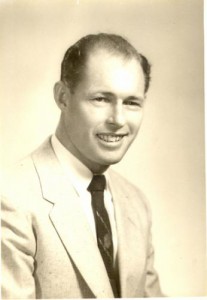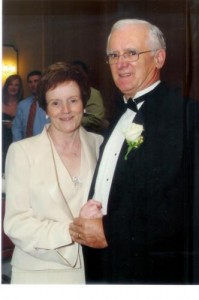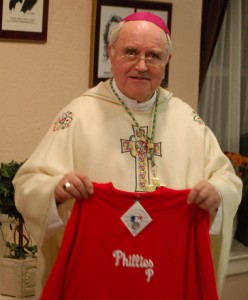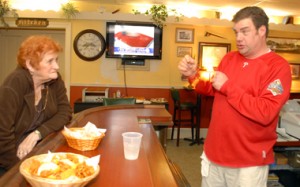By Kathy McGee Burns
Egan Family Rules
- Go to church every Sunday (and be on time)
- Go to College (and they all did)
- Vote in every election (and try to make that a Democratic vote)
When I arrived at Bridey Egan’s home to interview her, I was delighted to see a very large, 3-story, white-washed stucco twin Victorian with six bedrooms. I could just imagine it burgeoning with the laughter and frolicking of the family of 12 Egans in their younger years. The inside was full of family portraits, mementos and a lot of memories. We sat around the kitchen table and talked about her late husband, Pat, who will be inducted into the Delaware Valley Irish Hall of Fame on Sunday.
In the townland of Clydagh, a rural area, south-west of Headford , County.Galway, lies the farm in which the Egan family called home. This community is nestled on the north eastern shore of Lake Corrib, the second largest fresh water lake in Ireland. The parents, Thomas (called Kenny Egan) and Nora Walsh Egan raised seven children there. Patrick was the oldest. He attended Clydagh National School, which is now150 years old. In May 1948, at the age of 24. he came to America, settling in Bryn Mawr with his Aunt Sarah McMahon. He wanted to better himself and had no desire to be a farmer. This was after the war years and immigration had opened up. He took menial jobs to get started and soon became a lineman for Suburban Water Company.
Typical of a young, single Irishman, he attended the 69th Street dances. This is where he met and fell in love with the beautiful Mayo girl, Bridget Feeley. She and her sister, Frannie, had come to Fishtown on a lark, never intending to stay. Bridey’s encounter with Pat Egan certainly changed the mind of the daughter of Michael and Margaret Feeley of Ballyhaunis.
Pat and Bridey were married for 57 years and had 10 childre: Mary, Peggy, Noreen, Tom, Bernadette, Anne, Michael, John and Joe, and Frances. They lost a daughter, Patricia, at the age of 10 weeks. They settled in Ardmore and became parishioners of St. Colman’s.
Patrick Egan was involved with the GAA (Gaelic Athletic Association) from 1948 to 1954. He played for Galway and captained the team. In the early days, there was very little local competition so the team traveled to various states, including New York and Washington. His son, Mike, told me that as much as he loved Irish sports, he was very much Americanized and encouraged his sons to play football. He was also an avid Phillies fan. The family regretted that Pat was not alive to see the Phil’s win the championship last year. Knowing him, they said, he was probably calling the shots in Heaven.
There was a lot of Irish culture in the Egan home—plenty of Irish music and the beloved Sunday radio shows. Pat was a member of the Galway Society from 1948 to 2007. He was president many times over.
A stone mason most of his life, he rebuilt the steps of St. Colman’s Church. In 1994, he was featured on the TV show, This Old House, and was considered an expert in the lovely work he did. I saw some of his beautiful designs, which are on the front porch of his home. After his death, someone wrote a note to Bridey saying that they would think of Pat every time they climbed the steps of St. Colmans.
The only other Egan to come to America with Pat was his brother, John. They were best friends and fellow Phillies attendees. John was the youngest of the Galway Egans and served as best man at his brother’s wedding.
Patrick Egan was grateful to all the Irish who helped him when he came to the Phila-
delphia area and he in turn helped many others. Michael Egan told me that his father was intelligent, honest, hard working, tough, dignified, a gentleman and a caring human being. Although he had a limited formal education, he was well read. He devoured several newspapers each day, loved crossword puzzles and had a fabulous vocabulary. His love of knowledge made him adamant about each of his children getting a college degree. Pat realized the vast opportunities that this country presents and the surest path to taking full advantage was a good education.
Bridey said how much fun he was. That’s why she married him. John Egan said that they were a devoted couple, very much in love.
Mike shared some funny stories. One of Pat’s passions was Monday night bowling,
so much so that the family joke was if Mom died first she can’t be laid out on Monday night. Dad wouldn’t be able to make it!
The other story was about Pat’s strict curfew rules, especially for the older children. Some young man had brought one of the girls home past curfew. Pat chased him down the driveway, caught up with the lad and said,” Don’t come back if you can’t get my daughter home on time.” They never saw that guy again and thankfully he relaxed his rules after the first six children.
When Bridey and I were finished talking, she shared some of the many cards she received after Pat’s death. I think these sentiments people wrote clearly defines Patrick Egan:
“We have memories of enjoyable conversations, friendly exchanges, and assistance with community efforts.”
“His elegance, gentleness, religious commitment and work effort will continue to inspire us.”
This is the measure of a good man.





